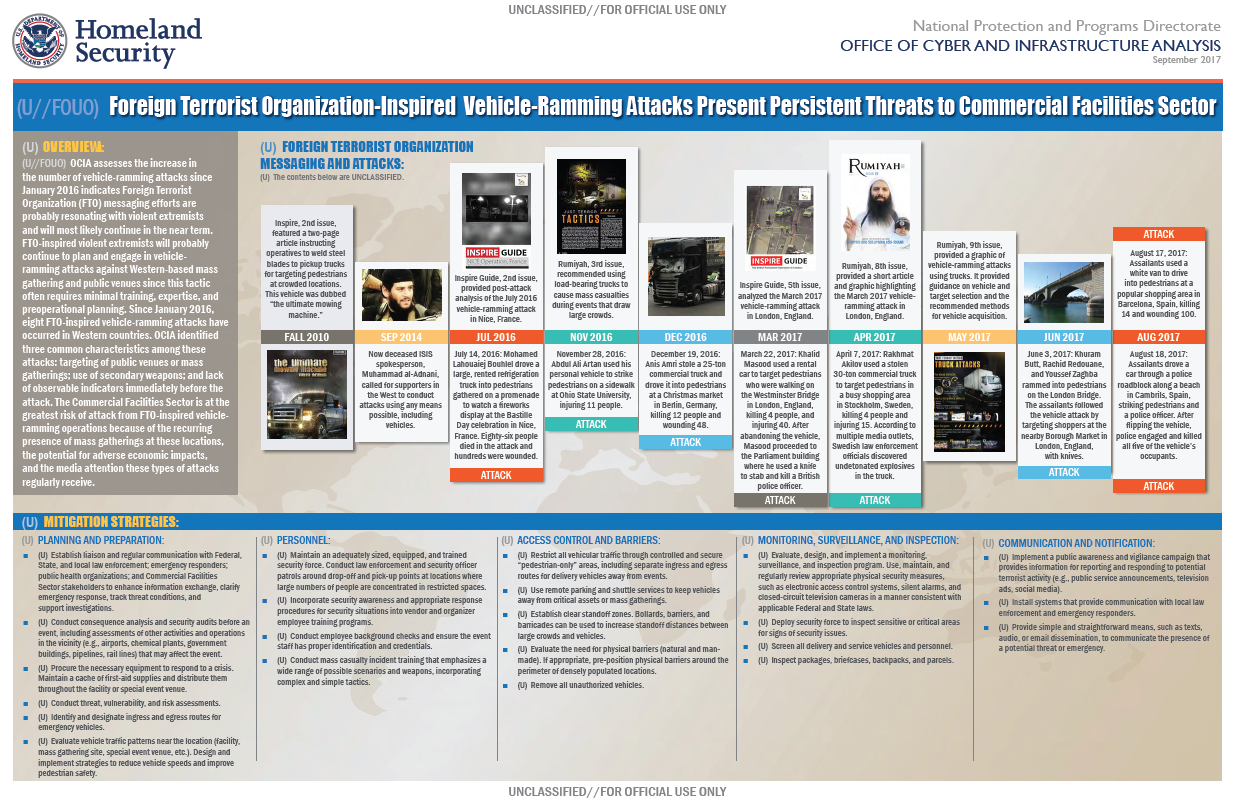(U//FOUO) OCIA assesses the increase in the number of vehicle-ramming attacks since January 2016 indicates Foreign Terrorist Organization (FTO) messaging efforts are probably resonating with violent extremists and will most likely continue in the near term. FTO-inspired violent extremists will probably continue to plan and engage in vehicle-ramming attacks against Western-based mass gathering and public venues since this tactic often requires minimal training, expertise, and preoperational planning. Since January 2016, eight FTO-inspired vehicle-ramming attacks have occurred in Western countries. OCIA identified three common characteristics among these attacks: targeting of public venues or mass gatherings; use of secondary weapons; and lack of observable indicators immediately before the attack. The Commercial Facilities Sector is at the greatest risk of attack from FTO-inspired vehicle-ramming operations because of the recurring presence of mass gatherings at these locations, the potential for adverse economic impacts, and the media attention these types of attacks regularly receive.
(U) PLANNING AND PREPARATION:
(U) Establish liaison and regular communication with Federal, State, and local law enforcement; emergency responders; public health organizations; and Commercial Facilities Sector stakeholders to enhance information exchange, clarify emergency response, track threat conditions, and support investigations.
(U) Conduct consequence analysis and security audits before an event, including assessments of other activities and operations in the vicinity (e.g., airports, chemical plants, government buildings, pipelines, rail lines) that may affect the event.
(U) Procure the necessary equipment to respond to a crisis. Maintain a cache of first-aid supplies and distribute them throughout the facility or special event venue.
(U) Conduct threat, vulnerability, and risk assessments.
(U) Identify and designate ingress and egress routes for emergency vehicles.
(U) Evaluate vehicle traffic patterns near the location (facility, mass gathering site, special event venue, etc.). Design and implement strategies to reduce vehicle speeds and improve pedestrian safety.
(U) PERSONNEL:
(U) Maintain an adequately sized, equipped, and trained security force. Conduct law enforcement and security officer patrols around drop-off and pick-up points at locations where large numbers of people are concentrated in restricted spaces.
(U) Incorporate security awareness and appropriate response procedures for security situations into vendor and organizer employee training programs.
(U) Conduct employee background checks and ensure the event staff has proper identification and credentials.
(U) Conduct mass casualty incident training that emphasizes a wide range of possible scenarios and weapons, incorporating complex and simple tactics.
(U) ACCESS CONTROL AND BARRIERS:
(U) Restrict all vehicular traffic through controlled and secure “pedestrian-only” areas, including separate ingress and egress routes for delivery vehicles away from events.
(U) Use remote parking and shuttle services to keep vehicles away from critical assets or mass gatherings.
(U) Establish clear standoff zones. Bollards, barriers, and barricades can be used to increase standoff distances between large crowds and vehicles.
(U) Evaluate the need for physical barriers (natural and manmade). If appropriate, pre-position physical barriers around the perimeter of densely populated locations.
(U) Remove all unauthorized vehicles.
(U) MONITORING, SURVEILLANCE, AND INSPECTION:
(U) Evaluate, design, and implement a monitoring, surveillance, and inspection program. Use, maintain, and regularly review appropriate physical security measures, such as electronic access control systems, silent alarms, and closed-circuit television cameras in a manner consistent with applicable Federal and State laws.
(U) Deploy security force to inspect sensitive or critical areas for signs of security issues.
(U) Screen all delivery and service vehicles and personnel.
(U) Inspect packages, briefcases, backpacks, and parcels.
(U) COMMUNICATION AND NOTIFICATION:
(U) Implement a public awareness and vigilance campaign that provides information for reporting and responding to potential terrorist activity (e.g., public service announcements, television ads, social media).
(U) Install systems that provide communication with local law enforcement and emergency responders.
(U) Provide simple and straightforward means, such as texts, audio, or email dissemination, to communicate the presence of a potential threat or emergency.

